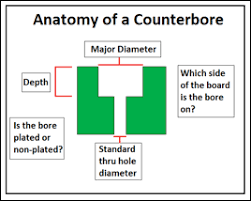COUNTER SINK
Countersinking is done by making a cone shaped hole which allows a flat head fastener to sit flush when installed. This prevents any snagging or damage from the top of the fastener, which can happen if it isn't flush to the surface.
With wood if you don't countersink and force the screw into the surface it will not only look bad, but the stability of the wood will be compromised. The wood can crack and split from the screw being forced and the fibers become damaged and dented. Countersinking also allows you to have all your screws at the same consistent depth.
COUNTERBORE
Counterbore is a similar concept to countersinking except the hole is bigger with a flat bottom to allow the screw or bolt to fit into and be flush to the surface. The screw or bolt has a flat underside that allows a sturdy stable hold.
The counterbore is often made large enough for a socket to go on the fastener for attachment.
The below anatomy will help to understanding them more easily.


The Counter sink are used more in Headpcb's experience, so we explain the application ans angles for counter sink individually.
Countersinks have a greater range of applications and angles. In Headpcb's drill bite warehouse, standard sizes include 60°, 82°, 90° as well as less popular 100°,110⁰ and 120° included angles. Because of the angle on this shank driven rotary tool they can be used to remove burrs or chamfer the corner of a part.

Many styles of countersink are popular and each has distinct advantages. Fluteless countersinks are cone shape in the desired included angle with a hole drilled through the side of the cone, clearance exists to ensure free cutting. The most practical use is deburring.
Single and multiple flute countersinks are used to chamfer threaded holes or provide a good seat for counter sunk fastener. There are also tools designed to chamfer or face the back side of a drilled or tapped hole. The shank of the tool is inserted through the drilled or tapped hole and a cutter is assembled on the back side. The tool is then rotated and performs the chamfering or face operation.
Additionally there is another similar tool called a combination drill and countersink. These doubled ended tools are used to produce a center in the end of a round product so that the part can be held between centers on a lathe or CNC machine.








